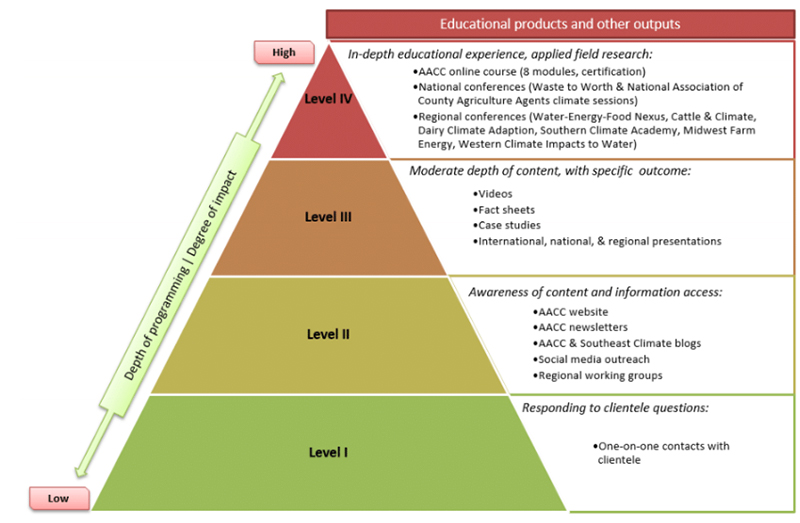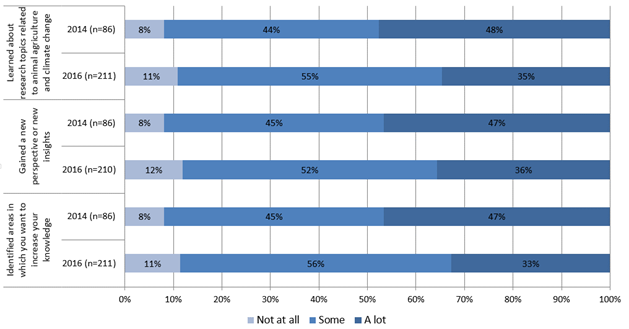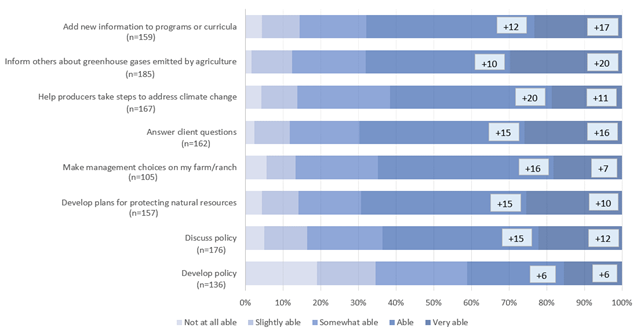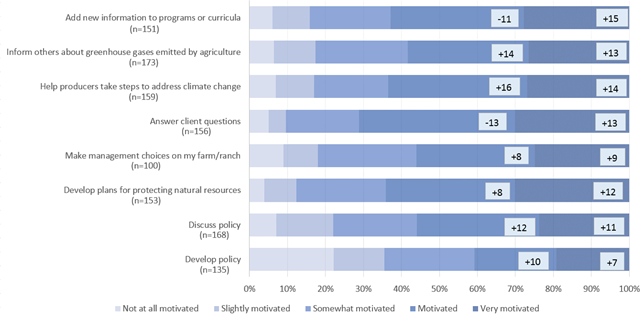 |
February 2018
|
February 2018 // Volume 56 // Number 1 // Feature // v56-1a8
Building Capacity within Extension to Address Animal Agriculture in a Changing Climate
Abstract
The Animal Agriculture in a Changing Climate project was formed to build capacity among Extension professionals and other livestock advisors to address climate change issues. We offer a case study of how a small team can build national capacity for new topics. We used a coordinated multiregional approach to leverage national efforts applied to locally relevant climatology, production systems, and climate issues. Key insights on overcoming challenges centered on (a) engaging audiences with local, historical trends and agricultural impacts, (b) beginning with adaptation, rather than mitigation of climate change, and (c) providing strategies for effectively communicating science during controversy. Program participants found the project valuable and substantially increased their ability and motivation to apply climate science.
Climate change impacts on agricultural production are likely to affect both the national and global food supplies and related social and economic systems (U.S. Global Change Research Program, 2015). Given the cross-cutting social-environmental-economic implications of climate change, one can see why there is some urgency to generate new knowledge on this topic and disseminate knowledge in ways that can induce beneficial changes in practice. This is especially true for animal agriculture. On the one hand, animal agriculture is affected directly by changes in climate and, sometimes even more importantly, indirectly by impacts on forage and agronomic crop production. On the other hand, although it is identified as a relatively minor source (4%–6%) of total U.S. greenhouse gas emissions (U.S. Environmental Protection Agency, 2016), livestock production has been the target of much negative press, calls for consumer avoidance of particular products, and regulatory attention related to lessening the United States' contribution to greenhouse gas emissions and global warming.
Extension has great potential to affect the adoption of adaptation and mitigation practices (Morris, Megalos, Vuola, Adams, & Monroe, 2014). Unfortunately, lack of existing Extension capacity—in terms of both limited content expertise and limited time available for personnel to coordinate the development and delivery of programs in this new area—has hampered the translation of new climate change knowledge and tools to end users in most regions of the United States (Burnett, Vuola, Megalos, Adams, & Monroe, 2014).
In 2011, members of the Livestock and Poultry Environmental Learning Center (LPELC), an eXtension learning network, formed a team of 14 Extension specialists and professionals across six universities to implement an initiative we titled the Animal Agriculture in a Changing Climate (AACC) project. We established the project to leverage the limited Extension expertise that existed across the country in climate change adaptation and mitigation, with the goal of building capacity among Extension professionals and other livestock advisors to address climate change issues.
In this article, we describe how the AACC project team built Extension capacity at regional and national scales on this new topic through
- facilitating a nationally coordinated, multiregional effort to reach Extension professionals with targeted programs and locally relevant resources,
- developing strategies for overcoming barriers to effective audience engagement on climate-related issues on livestock farms, and
- improving Extension professionals' levels of ability and motivation to address climate issues.
Our work serves as a case study of how a small team can build national capacity for addressing emerging topics.
Methods
Reaching Extension Professionals
Like those working on other Extension programs in new topic areas, we first set about clearly identifying and effectively engaging target audiences to determine program needs—in our case, at national, regional, and local scales. We then could assess how to disseminate information to and communicate with these audiences.
Target audiences. The main target audience for the AACC project was Extension personnel, primarily those with interest in agriculture and natural resources and, specifically, livestock production. Others with advisory/Extension roles, including U.S. Department of Agriculture (USDA) Natural Resources Conservation Service personnel, industry representatives, and consultants, were an important, though secondary, audience. The LPELC's established audience of Extension specialists and educators, researchers, technical service providers, agricultural teachers, regulatory agency staff, and progressive producers served as an initial pool of participants. Many participants without previous affiliation with the LPELC were drawn in later as well.
Program needs. We chose a multiregional approach that facilitated both coordination of efforts nationwide and the ability to tailor programs to regional climatic conditions and differing production systems. Team members worked with Extension contacts and stakeholder representatives in each region to form a working group that coordinated and advised Extension efforts related to animal agriculture in a changing climate within the region. The five resulting working groups were as follows:
- Midwest (10 members from 10 states),
- Southeast (18 members from 10 states),
- Southwest (seven members from six states),
- West (30 members from 10 states), and
- Northeast (18 members from eight states).
The working groups met periodically to assist in determining ongoing program needs and to evaluate program materials prior to broader application. They also participated in the evaluation of project programs and in identification of additional topics or needs for future programs.
Dissemination of information. We developed a website portal (http://articles.extension.org/pages/60702) that was integrated with the existing LPELC eXtension website. As of September 2016, our website had had nearly 5,900 users and over 21,100 total page views. Project videos, including recordings from many of the face-to-face conferences, had received nearly 8,900 views. The website hosts a resource list that contains all the online course content, project fact sheets, and videos, as well as links to other relevant national and regional websites. Project materials were promoted through various online outlets: As of September 2016, the weekly AACC blog was sent to 990 people; the daily Southeast Climate Blog had received over 12,000 site visits; regional project newsletters were sent to 627 stakeholders; and modest social media efforts had 225 followers.
Addressing Barriers
Early interactions with our target audience confirmed barriers that had been reported as affecting others involved in educational programs on contentious issues such as climate change and revealed some additional barriers to engagement of Extension personnel.
We widely implemented two strategies for engaging our audience on climate issues: (a) start the conversation around locally impactful issues, and (b) frame the discussion and science in a way that will cause it to be processed, not rejected. Like other project teams, we observed fairly wide agreement among our audience members that weather extremes and changing, variable climatic conditions were readily acknowledged to exist locally and were recognized as having significant local impacts, whereas there were very diverse and often strong and divergent reactions to broader topics, such as climate change, global warming, and greenhouse gas emissions. So all of our major efforts started with discussion of local trends and impacts. This strategy was successful with Extension educators because many were involved with farming or ranching operations and could see the approach being successful with their clientele. Framing the discussion involved really thinking about how the science around a topic is presented so that it will be considered and not reactively rejected. Having Extension specialists present information, encouraging producers to share their experiences, and getting feedback from working groups were pivotal strategies for achieving desired levels of dialogue.
Other barriers we identified had more to do with educator time availability and priorities. Limited time was a key barrier, which we were not able to address beyond making information more readily accessible. Regarding priorities, we worked on a regional basis to have Extension administrators clarify the importance of the topic area in their states and, in a number of cases, allocate some resources to support time and travel to participate in our professional development programs.
Improving Ability and Motivation
Beginning in 2011, our team created a suite of educational programs and products to build capacity in Extension professionals across the United States. The educational outputs of the project were purposefully planned to address different needs for depth of programming and to produce varying levels of impact, as outlined in Figure 1.
Figure 1.
Animal Agriculture in Climate Change (AACC) Project Programming Plan

A train-the-trainer approach was employed for professional development. We provided ready-to-use videos, slide sets, and fact sheets for educators and teachers to download for use in programming. Over 390 presentations were given by project personnel at local, regional, and international meetings and conferences.
Online course. Key products of the project were two online courses: a basic Climate Science online course (five modules) and a comprehensive Animal Agriculture in a Changing Climate online course (seven modules, 15 hr). The comprehensive AACC course structure allowed the user to select regional and species-specific content. The modules covered the topics of
- climate trends,
- climate impacts,
- adaptation and risk management,
- climate science,
- greenhouse gases and life cycle assessment,
- greenhouse gas regulation and markets, and
- climate change communication.
Through the first 4 years, 321 participants registered, and the completion rate was 38%. Full details of this program development can be found in Whitefield et al., 2016.
Conferences and other events. Other key educational products were national and regional symposiums and workshops. These endeavors were conducted as a mix of stand-alone events and collaborative additions to existing professional conferences, with our goal being to reach a diverse audience within animal agriculture with content that ranged in depth. We organized 13 face-to-face conferences that drew approximately 1,590 attendees. Regional conferences emphasized the climate-related needs specific to that region, as guided by the working groups.
One project objective was to coordinate the wide variety of climate resources available to Extension, making them more accessible and easier to use. We coordinated with representatives of 14 related research and education projects to create joint conferences and training programs, highlight relevant resources, and facilitate the translation of new research findings.
Outcomes
In 2014, we surveyed those who had participated in one or more of the project programs and provided email contact information, resulting in a pool of 567 participants. In January and February of 2016, a second survey of 1,506 program participants was fielded on the web. The surveys were developed, administered, and analyzed by the Bureau of Sociological Research at the University of Nebraska–Lincoln. The Internal Review Board at the University of Nebraska deemed the survey exempt based on its status as "not human subject research."" The survey and follow-up reminders were delivered via email, with each participant being given a unique token that could be used only once. The software kept the responses anonymous to the reviewers. The survey response rates were 19.4% in 2014 and 18.7% in 2016.
Twenty-five total questions were asked. No questions were required to be answered. Ten were multiple-choice questions about the survey takers' participation in project programming and its effectiveness. Seven were open-ended questions about project programming. Eight were questions eliciting demographic information, including occupation, region, and primary clientele.
Target Audience
Results of both surveys indicated that we were reaching our target audience—a large portion of respondents reported their occupations as being in Extension (39.5% in 2014, 39.0% in 2016), research (16.4% in 2014, 20.2% in 2016), or advising (16.4% in 2014, 19.5% in 2016). The respondents were evenly distributed throughout the United States and represented all the major livestock species: dairy, beef, swine, poultry, and equine.
Program Impacts
Overall, participants found the project resources valuable, as indicated by the data shown in Figure 2, particularly the project website, the online course, and regional meetings. The project also gave a third to nearly half of the participants opportunities to learn about AACC research, gain new perspectives, and identify professional development needs (see Figure 3).
Figure 2.
Value of Animal Agriculture in Climate Change Programs and Educational Resources

Reported by those respondents for whom the item was applicable during the year surveyed (n).
Figure 3.
Benefits Gained by Participation in Animal Agriculture in Climate Change Programs

Reported by those respondents for whom the item was applicable during the year surveyed (n).
Ability to address climate issues. A key measure we addressed was how participants felt their capabilities related to eight important skills had changed as a result of participation in the project. Overall, 60% or more of the respondents in both surveys reported being able or very able to perform all eight skills after participation in AACC programming, indicating significant increases in their perceptions of their abilities from before participation in the programming (see Figure 4 for 2016 data). The largest gains were for helping producers take steps to address climate change (proportion grew 31 percentage points [+31%]), answering client questions (+31%), and informing others about greenhouse gases emitted by agriculture (+30%). We identified even greater growth in ability (able or very able) among those who had had more involvement in the AACC program because of participating in two or more AACC activities. This difference was particularly pronounced for answering client questions (additional 21 percentage points greater for those who participated in two or more activities [+21%]), adding new information to programs or curricula (+20%), and helping producers take steps to address climate change (+19%).
Figure 4.
Change in Abilities as a Result of Participation in the Animal Agriculture in Climate Change Project

Proportions of 2016 survey respondents who reported their ability to do the identified skills after using AACC resources. Values inside bars indicate change from before use of AACC resources.
Motivation to address climate change. The second key measure was how participants felt their motivation had changed related to performing the eight important skills. After participation in AACC programming, a majority of respondents reported having motivation to perform the skills, as indicated by the data shown in Figure 5. Across all skill areas, a sizable increase in respondent motivation (motivated or very motivated) existed after participation in the programming compared to before participation in the programming, particularly for helping producers take steps to address climate change (+30%), informing others about greenhouse gases emitted by agriculture (+27%), adding new information to programs or curricula (+26%), and answering client questions (+26%). Even greater increases in motivation were reported by those who were more involved in the AACC program (participated in two or more AACC activities). This effect was particularly pronounced for informing others about greenhouse gases emitted by agriculture (additional 27 percentage points greater for those who participated in two or more activities [+27%]), helping producers take steps to address climate change (+24%), and adding new information to programs or curriculum (+23%).
Figure 5.
Change in Motivation as a Result of Participation in the Animal Agriculture in Climate Change Project

Proportions of 2016 survey respondents who reported their ability to do the identified skills after using AACC resources. Values inside bars indicate change from before use of AACC resources.
Discussion
Our team quickly realized that the challenge was not a lack of science and educational materials, but how to effectively structure and engage around the topic. We found it highly effective to have our first program effort be the comprehensive online course. This allowed our team to become more knowledgeable on the topic and illuminated key issues so that we could agree on a single, coherent base of knowledge. Having that common base allowed us to focus and refine the project on regional and species-specific issues as we developed later programming.
Extension professionals have diverse views of climate change, reflecting similar patterns in their stakeholders (Adams, Monroe, Plate, & Wojcik, 2012), ranging from very engaged to dismissive, but with the majority being "cautious" or "concerned." We found that professional development materials needed to be responsive to this diversity. Two key strategies identified by the regional working groups were (a) to start programming with a discussion of historical trends and agricultural impacts, as locally relevant as possible (Cambell Hibbs et al., 2013), and (b) to start the discussion around adaptation rather than mitigation. We found that statements about changes that are already apparent in the climatic record and ways agriculture has adapted in the past and is adapting to more recent weather variability and climatic changes often were excellent discussion starters, reducing the barriers to engaging in the topic (Morris et al., 2014).
Another identified key challenge was that many project participants expressed comfort with the science of climate change but were uncomfortable and unsure about how to effectively communicate the science in the sometimes hostile or controversial discussions that surround climate change. This circumstance led us to study the body of research on climate science communication methods and to include climate science communication in each of the project's professional development offerings. The evaluation data from individual project programs show that communication strategies were consistently rated as one of the most valuable topics (online course data, Whitefield et al., 2016).
Currently, climate change is still a challenging subject for Extension programming for various reasons. Lack of available time was identified as the main barrier for engaging in climate change programming (68% of respondents), and this barrier will likely continue to be the biggest challenge to building capacity in this topic. However, Extension will continue to be asked to engage in ever broader applications of science and to make the science locally relevant. We believe this method of using focused, small teams to create a base of knowledge and content can be an effective way to leverage Extension professionals' limited time.
Targeting farm advisors also may be an effective way to leverage our limited time for more impact. Farmers trust Extension as a source of climate change information (Cambell Hibbs et al., 2013); however, they are now often seeking information primarily from other advisors, such as nutritionists, veterinarians, and various other consultants (Prokopy & Power, 2015). These other advisors also report trusting Extension as a source of climate change information (Prokopy & Power, 2015), so Extension may need to target these clientele for future climate programming. Materials developed to train the trainer, such as those we used for our AACC program, can easily be further used to train a wider variety of farm advisors.
In conclusion, the response from AACC project participants indicates that combining programming that addresses regional impacts and needs with strategies for how to communicate the necessary information can be highly effective in increasing Extension professionals' levels of ability and motivation to use climate change information in a range of applications. This methodology allowed a relatively small team of Extension professionals to build national capacity to address climate change.
Acknowledgments
This project was supported by Agricultural and Food Research Initiative Competitive Grant No. 2011-67003-30206 from the USDA National Institute of Food and Agriculture.
References
Adams, D. C., Monroe, M. C., Plate, R., & Wojcik, D. (2012). The six Americas of climate change: Perceptions of Southeast Extension professionals. Retrieved from http://www.pinemap.org/publications/research-summaries/extension/Six_Americas.pdf
Burnett, R. E., Vuola, A. J, Megalos, M. A., Adams, D. C., & Monroe, M. C. (2014). North Carolina Cooperative Extension professionals' climate change perceptions, willingness, and perceived barriers to programming: An educational needs assessment. Journal of Extension, 52(1), Artlce 1RIB1. Available at: http://www.joe.org/joe/2014february/rb1.php
Campbell Hibbs, A., Kahl, D. W., PytlikZillig, L., Champion, B., Abdel-Monem, T., Steffensmeier, T. R., . . . Hubbard, K. (2013). Agricultural producer perceptions of climate change and climate education needs for the Central Great Plains. Journal of Extension, 52(3), Article 3FEA2. Available at: http://www.joe.org/joe/2014june/a2.php
Morris, L., Megalos, M., Vuola, A., Adams, D., & Monroe, M. (2014). Cooperative Extension and climate change: Successful program delivery. Journal of Extension, 52(2), Article 2COM3. Available at: http://www.joe.org/joe/2014april/comm3.php
Prokopy, L., & Power, R. (2015). Envisioning new roles for land-grant university Extension: Lessons learned from climate change outreach in the Midwest. Journal of Extension, 53(6), Article 6COM1. Available at: http://www.joe.org/joe/2015december/comm1.php
U.S. Environmental Protection Agency. (2016). Inventory of U.S. greenhouse gas emissions and sinks: 1990-2014. Retrieved from https://www3.epa.gov/climatechange/ghgemissions/usinventoryreport.html
U.S. Global Change Research Program. (2015). Climate change, global food security, and the U.S. food system. Retrieved from http://www.globalchange.gov/browse/reports/climate-change-global-food-and-security-and-us-food-system
Whitefield, E. M., Schmidt, D., Witt-Swanson, L., Smith, D. W., Powers, C., Pronto, J. L., & Knox, P. (2016). Animal Agriculture in a Changing Climate online course: An effective tool for creating Extension competency. Journal of Extension, 54(2), Article 2TOT6. Available at: https://joe.org/joe/2016april/tt6.php




